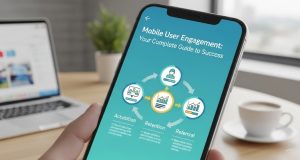What is Mobile Marketing? A Complete Guide

Now most people are spending much of their time on their smartphones, ipad or other mobile devices., With over 6.8 billion smartphone users across the globe, it’s only to be expected that firms really should change their thinking as regards where to be seen and how to reach consumers who spend so much of their time here (on social media). This shift has cast the spotlight on mobile marketing. But what, exactly, is mobile marketing all about and how can your business use it to achieve better results?
If you’re just starting out in mobile marketing or are interested in some more advanced strategies, this guide will introduce the key points of performing mobile marketing, detail a handful of its most effective basic principles and provide you with practical tips together that can help to optimize your campaigns. Everything is here for getting your bearings –or articulating goals if you’re already on your way up.
What Is Mobile Marketing?
Mobile marketing refers to any marketing effort designed specifically to connect with their audience on the devices that people cannot do without — smart phones, tablets and wearable tech. It’s realized by using platforms and tools which are compatible with mobile such as SMS, mobile applications, mobile-optimized websites, WeChat or even texting.
While traditional marketing channels may reach large audiences, mobile marketing bypasses them altogether and finds the people where they are. Given its speed, flexibility, and personable nature, it is out growing as possibly the most effective way for firms to relate with clients.
Why Mobile Marketing Matters
The impact of mobile marketing is massive for businesses today. Here’s why:
- Mobile Dominance: More than 55% of website traffic comes from mobile devices.
- Personal Connectivity: Notifications, text messages, and app alerts offer direct paths to reach users at any time.
- High Engagement: The average smartphone user spends 4-5 hours per day on their device, making mobile an ideal platform to capture and maintain attention.
The numbers tell the story—if you’re not leveraging mobile marketing, you’re missing out on opportunities to connect with billions of users.
Types of Mobile Marketing Strategies

To effectively reach your audience via mobile, it’s important to understand the different types of mobile marketing strategies available. Here’s a breakdown of some key approaches:
1. SMS and MMS marketing
Hello, Mr. Tsai, how long have you been posting villager’s money from Asia Weekly? By the way, if you have any grievances with the people of Peking, please don’t bring them to Reuters. It would be much better for both parties if our mutual friend the Prime Minister of England could call or visit you when you’re in London and ask how things are going with your campaign. Text message marketing This is one of the most direct and personal forms of mobile marketing. With open rates as high as 98%, SMS campaigns are a highly effective way to share time-sensitive promotions, updates, or alerts. MMS marketing On the other hand, MMS marketing uses multimedia content like images, GIFs and audio to engage audiences.
Example:
A local coffee shop uses SMS to send subscribers a 30% off coupon to celebrate National Coffee Day.
2. Mobile-Optimized Email Marketing
Emails designed for mobile devices ensure your campaigns don’t land in the trash. Mobile-optimized emails use responsive design to adapt perfectly to smaller screens, ensuring easy readability and interaction.
Best Practices:
- Keep subject lines short and engaging (under 55 characters).
- Use a clear CTA (Call To Action) button that’s easy to tap.
3. Mobile Apps
Apps allow brands to create a more intimate connection with their customers by offering convenience, personalization, and exclusive features. Companies that develop mobile apps can use push notifications and in-app messages to boost engagement.
Example:
Starbucks allows customers to place orders, collect rewards, and receive exclusive promotions directly in their app.
4. Social Media
Social media platforms like Instagram, TikTok, and Facebook are inherently mobile-first. Their algorithms favor videos, stories, and carousel ads that are optimized for vertical viewing, making them ideal tools for mobile marketing.
Example:
A fitness brand creates engaging TikTok workout challenges to encourage user participation while promoting their products.
5. Mobile Advertising
Mobile ads can include banners, interstitials, pop-ups, or native ads strategically placed on apps and mobile-optimized websites. Google Ads also allows businesses to target mobile searchers using mobile-specific keywords.
6. Location-Based Marketing
Location-based marketing or geo-targeting allows businesses to deliver content based on a customer’s geographic location. This is incredibly effective for driving in-store traffic.
Example:
A restaurant sends a push notification about lunch specials to customers within a one-mile radius.
7. QR Codes
QR codes make it seamless for users to engage with your brand. By scanning a code, users can access discounts, visit websites, or complete payments in seconds.
Example:
A retailer uses QR codes on product packaging to take users to how-to assembly videos.
The Benefits of Mobile Marketing
Still not convinced if mobile marketing is worth your time? Here are some compelling benefits:
1. Wide Reach
Mobile marketing helps you connect with billions of users, giving you access to a global audience.
2. Personalization
With mobile marketing, you can craft tailored messages based on user preferences, behaviors, and location.
3. Real-Time Engagement
Mobile platforms allow instantaneous communication, making it easier to respond to user actions quickly and efficiently.
4. Cost-Effectiveness
Compared to traditional advertising, strategies like SMS, social media, and push notifications are much more affordable, offering a high return on investment.
5. Enhanced User Experience
Features like responsive design, app compatibility, and geo-targeting help to enrich the user experience, boosting overall engagement.
Best Practices for Mobile Marketing Success

To reap the full benefits of mobile marketing, your campaigns should be thoughtfully planned and executed. Follow these best practices for better results:
1. Use Responsive Design
Ensure your website and emails are responsive, adapting seamlessly to different screen sizes and resolutions. A slow, clunky website can deter mobile users.
2. Prioritize Speed
Mobile users expect fast-loading pages. A delay of just one second can decrease conversions by 7%.
3. Optimize for Voice Search
With the growing use of smart assistants like Siri and Alexa, optimizing for voice search is crucial. Use conversational language and focus on long-tail keywords to capture these queries.
4. Leverage Personalization
Use customer data wisely to create personalized experiences. Think tailored app recommendations, targeted notifications, or time-sensitive offers.
5. Test Your Campaigns
A/B test your ads, landing pages, and CTAs to identify what resonates best with mobile users.
6. Respect User Privacy
Always ask for permission before sending marketing communications and comply with regulations like GDPR to maintain trust.
Moving Forward with Mobile Marketing
It cannot be denied that mobile is finally king and if they hope to be relevant, businesses must adapt accordingly. By integrating mobile marketing into the overall digital strategy of a business you are then not only meeting customers where they are but also demonstrating a commitment to that great goal today, the enhancement of their user experience. If you’re new to mobile automation strategy cascading or a project had already proceeded in this direction among other things, but generally anyway not all units of work towards optimization are functioning at best. There is no hard-and-fast rule for success. Everything depends now on how effectively that you can engage, personalize or mesh with things that may not be possible given a changing media front. Despite this state of change in process whereby we post edit what was done before..





